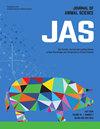Late gestation maternal overnutrition alters gene expression and histomorphology in neonatal foal testes
IF 2.7
2区 农林科学
Q1 AGRICULTURE, DAIRY & ANIMAL SCIENCE
引用次数: 0
Abstract
Reproductive health of male offspring following perturbations in maternal nutrition is not well described in the horse; therefore, the objective of this study was to determine the effects of maternal overnutrition on neonatal foal testicular development. Sixteen Quarter Horse mares were used in a completely randomized design and stratified by expected foaling date, body weight, and body condition score into one of two dietary treatments beginning on gestational day 235: control (CON; n = 8) fed to meet nutrient requirements and overfed (HIGH; n = 8) fed 40% above CON. At 5 h postpartum, foals were euthanized, and testes from male foals were harvested, weighed, and stored for analyses. Samples were numerically coded in a blinded fashion and processed randomly to eliminate bias. Histomorphometric evaluations were performed following a hematoxylin & eosin stain and evaluated using ImageJ. All data were analyzed using the MIXED procedure in SAS v9.4. Horse within treatment serves as a random effect, with a main effect of treatment. For RNA sequencing, differential gene expression analysis used DESeq2 1.20.0 R package to compare gene expression levels between CON and HIGH, and P-values were adjusted using the Benjamini-Hochberg correction. The threshold for significance was set at P ≤ 0.05 with trends toward significance at 0.05 < P ≤ 0.10, with sequencing data using adjusted P-values. Stringency was set to include differentially expressed genes with an unadjusted P-value < 0.05 for pathway enrichment analysis. Testes from HIGH foals (n = 4) were 61% heavier than testes from CON foals (n = 4; P < 0.01). There was no difference in individual seminiferous tubule area (P = 0.76) or Sertoli cell number within tubule (P = 0.57); however, testes from HIGH foals had 2.3 times fewer tubules per 10× magnification field than CON foals (P = 0.01). Further, tubules represented a lesser percentage of image area relative to interstitial tissue in testes from HIGH foals (P = 0.05). RNA sequencing revealed 56 differentially expressed genes between HIGH and CON testes (P-adjusted < 0.05). Differentially expressed genes represented biological processes related to steroidogenesis, cell regulation, and energy metabolism. Thus, late gestation maternal overnutrition alters fetal testicular development with potential long-term implications to reproductive function.妊娠后期母体营养过剩改变新生儿马驹睾丸的基因表达和组织形态学
在马的母体营养紊乱后,雄性后代的生殖健康没有得到很好的描述;因此,本研究的目的是确定母亲营养过剩对新生儿马驹睾丸发育的影响。16匹四分之一母马采用完全随机设计,并根据预期产驹日期、体重和身体状况评分进行分层,从妊娠第235天开始分为两组:对照组(CON;n = 8)满足营养需求和过量饲养(HIGH;n = 8)饲喂高于con 40%的饲料。产后5 h,对马驹实施安乐死,收集公马驹的睾丸,称重并保存以供分析。样本以盲法进行数字编码,并随机处理以消除偏差。在苏木精治疗后进行组织形态学评估;并用ImageJ进行评价。使用SAS v9.4中的MIXED程序分析所有数据。马内治疗作为一种随机效应,具有治疗的主要效果。对于RNA测序,差异基因表达分析使用DESeq2 1.20.0 R软件包比较CON和HIGH之间的基因表达水平,并使用Benjamini-Hochberg校正调整p值。显著性阈值设为P≤0.05,趋势为0.05 <;P≤0.10,测序数据采用调整后的P值。严格性设置为包括未调整p值的差异表达基因&;lt;通路富集分析0.05。HIGH马驹(n = 4)的睾丸比CON马驹(n = 4)的睾丸重61%;P, lt;0.01)。精子小管面积(P = 0.76)和小管内支持细胞数量(P = 0.57)差异无统计学意义;而在每10倍放大镜下,HIGH马驹的睾丸小管数量是CON马驹的2.3倍(P = 0.01)。此外,相对于高马驹睾丸间质组织,小管在图像面积中所占比例较小(P = 0.05)。RNA测序显示56个差异表达基因在HIGH和CON之间(p校正&;lt;0.05)。差异表达的基因代表了与类固醇生成、细胞调节和能量代谢相关的生物过程。因此,妊娠后期母体营养过剩会改变胎儿睾丸发育,对生殖功能有潜在的长期影响。
本文章由计算机程序翻译,如有差异,请以英文原文为准。
求助全文
约1分钟内获得全文
求助全文
来源期刊

Journal of animal science
农林科学-奶制品与动物科学
CiteScore
4.80
自引率
12.10%
发文量
1589
审稿时长
3 months
期刊介绍:
The Journal of Animal Science (JAS) is the premier journal for animal science and serves as the leading source of new knowledge and perspective in this area. JAS publishes more than 500 fully reviewed research articles, invited reviews, technical notes, and letters to the editor each year.
Articles published in JAS encompass a broad range of research topics in animal production and fundamental aspects of genetics, nutrition, physiology, and preparation and utilization of animal products. Articles typically report research with beef cattle, companion animals, goats, horses, pigs, and sheep; however, studies involving other farm animals, aquatic and wildlife species, and laboratory animal species that address fundamental questions related to livestock and companion animal biology will be considered for publication.
 求助内容:
求助内容: 应助结果提醒方式:
应助结果提醒方式:


